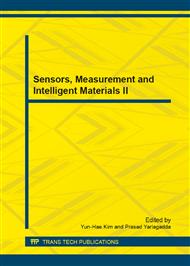[1]
Chung Deborah. D. L. Composite Materials: Science and Application Functional Materials for Modern Technologies. (2003).
Google Scholar
[2]
Zou H, Wu S, Shen J. Polymer/silica nanocomposites: Preparation, characterization, propertles and applications. Chem Rev, 2008, 108: 3893–3957.
DOI: 10.1021/cr068035q
Google Scholar
[3]
Jordan J, Jacob K I, Tannenbaum R, et al. Experimental trends in polymer nanocomposites—A review. Mater Sci Eng A, 2005, 293: 1–11.
Google Scholar
[4]
LU JiaLin, ZHANG BaoHua, LI DeFang. Development of dispersion research on SiO2 nano-coatings. Shanghai Chem Ind (in Chinese), 2004, 12: 33-35.
Google Scholar
[5]
XU Rui-dong, WANG Jun-li, HE Li-fang, GUO Zhong-cheng. Study on the characteristics of Ni-W-P composite coatings containing nano-SiO2 and nano-CeO2 particles [J]. Surface and Coatings Technology, 2008, 202(8): 1574−1579.
DOI: 10.1016/j.surfcoat.2007.07.012
Google Scholar
[6]
Wei Wu, Manfred H. Wagner, Zhongde Xu. Surface treatment mechanism of nano-SiO2 and the properties of PP/nano-SiO2 composite materials[J]. Colloid and Polymer Science . 2003 (6).
DOI: 10.1007/s00396-002-0802-0
Google Scholar
[7]
Qin Y, Dong J. Preparation of nano-compounded polyolefin materials through in situ polymerization technique: Status quo and future prospects. Chin Sci Bull, 2009, 54: 38–45.
DOI: 10.1007/s11434-008-0509-9
Google Scholar
[8]
M.A. Ahmed. Structural and nano-composite features of TiO2 –Al2O3 powders prepared by sol–gel method. [J]. Journal of Alloys and Compounds, 2010, 509(5).
DOI: 10.1016/j.jallcom.2010.10.172
Google Scholar
[9]
Sooyeon Kim. Surface modification of silica nanoparticles by UV-induced graft polymerization of methyl methacrylate. [J]. Journal of Colloid And Interface Science, 2005, 292(1).
DOI: 10.1016/j.jcis.2005.09.046
Google Scholar
[10]
Li Y, Fu S. Y, Li Y. Q, et al. Improvements in transmittance, mechanical properties and thermal stability of silica-polyimide composite films by a novel sol-gel route. Composites Science and Technology . (2007).
DOI: 10.1016/j.compscitech.2007.01.003
Google Scholar
[11]
Bikiaris D. N, Papageorgiou G. Z, Pavlidou E. et al. Preparation by melt mixing and characterization of isotactic polypropylene/SiO2 nanocomposites containing untreated and surface-treated nanoparticles. Journal of Applied Polymer Science . (2006).
DOI: 10.1002/app.22849
Google Scholar


